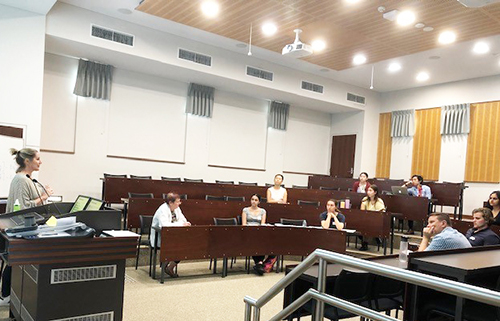In April, University of Wollongong (UOW) final year medical students joined their peers from the University of Sydney and Western Sydney University in a clinical skills training day at the University Centre for Rural Health’s Lismore campus. This was part of a week of training to prepare them for the Assistant in Medicine (AIM) program. Another ten UOW final year medical students, placed at UCRH’s Murwillumbah Hub, undertook similar training.
The AIM Program is a Department of Health initiative designed as a bridging program to fast track final year medical students into the medical workforce in preparation for the potential COVID-19 surge. The number of AIM positions available is yet to be determined and will be dependent on clinical need.
The Lismore day included a tutorial program covering practical processes such as handover and referral notes, completing discharge summaries, death certificates; interpretation of ABGs and ECGs as well as a session on breaking bad news. Students also rotated through practical skills stations including hand hygiene, appropriate use of personal protective equipment (PPE), IV cannulation, urinary catheterisation, basic life support, and suturing. These skills were delivered by a number of clinicians from the Northern NSW LHD, including Surgeons, Emergency Physicians and GPs.
The focus in Murwillumbah was similar, aiming to reinforce skills that the students had been developing during their course and providing an opportunity to practice skills or situations they may encounter as new practitioners in their AIM role. The day was also a mixture of tutorials and simulated practice, somewhat restricted because of social distancing requirements during the pandemic. We combined practice in handwashing and appropriate use of personal protective equipment (PPE) to be able to safely run Advanced Life Support (ALS) scenarios in which the students participated enthusiastically. Other skills and tutorials covered included ECG interpretation, arterial blood gases, urinary catheterisation, intravenous fluid administration, intravenous and intramuscular injections. There was special mention of the excellent sessions presented by Dr Marc Heyning and Dr David Engel.
The written and verbal feedback from the students at both training days was overwhelmingly positive. They said sessions were well presented and valuable in enabling them to improve their clinical expertise. The students also liked how we concentrated on things they have not had as much practice in their placement or during previous workshops/tutorials.
Facilitating such an event and respecting social distancing protocols during a pandemic presented a unique challenge, however by restricting group sizes and rotating students through small workshops this was achieved. Students commented that they felt more prepared and informed following the program.
The day would not have been possible without the support of the Lismore Regional Training Hub and the Local Health District who collaborated with the UCRH in the provision of resources and support. Thanks to the UCRH team for their hard work in developing and facilitating the workshop.
With the ‘flattening of the curve’, the availability of AIM positions may be less than originally thought when these sessions were planned. We wish all our students the best of luck in obtaining an AIM positions if/when they are required. Otherwise the workshop will be a valuable day spent honing their skills for when they complete their final requirements to become Interns next year.


















